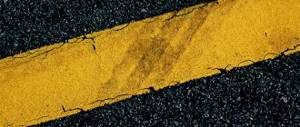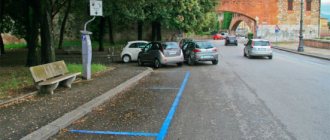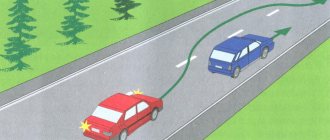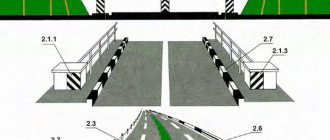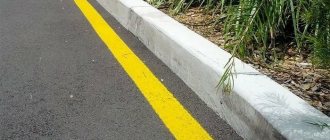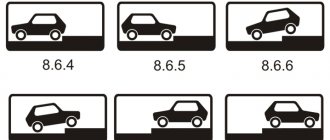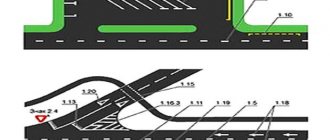The use of paints and varnishes is quite wide and varied. Modern technologies of the chemical industry make it possible to introduce them into more and more different areas, industries and productions. The development of advanced types of surface coating products is of a specialized nature. That is, a specific purpose of paint requires it to have the necessary properties for this purpose. This increases product efficiency, allowing for reduced volumes consumed in the same area as a result of improved material quality and durability.
Road markings in Russia
Thus, money is saved. And this is a very important indicator, especially if the use of paint and varnish products takes place in government affairs, because expenses are covered by allocations from the budget.
There is an expression in Russia that the two main problems that everyone and everywhere encounter are fools and roads. Let's focus on the latter. The condition of the road surface along its entire length leaves much to be desired. There are, of course, individual sections of tracks that meet all the established indicators and do not cause any complaints. But overall the situation is not very good.
This is due to the presence of potholes, uneven surfaces, and incorrect or missing lane markings in some places that motorists should follow. This leads to frequent accidents involving pedestrians, drivers of cars and trucks. The result is harm to the health and lives of people (mild, moderate, severe), causing material damage to the property of owners, blocking traffic flow and many other negative consequences.
One way to partially solve the existing problem regarding markings would be to use high-quality materials from the paint and varnish industry to apply identification elements to the asphalt surface. This is made possible by the creation of tools whose purpose is to exclusively perform this task.
Now let’s take a closer look at each of the questions: about the marking of the road surface, the paintwork materials for its application (characteristics of each type separately), the ways in which this process can be carried out, technical support, conditions that change the state of the paint present on the asphalt surface.
The most popular dyes
The following brands of paint are most often used on roads:
- "Line";
- Enamel AK-511;
- "Track".
These Russian-made paint and varnish solutions are adapted to harsh climatic conditions and can withstand high temperature changes and intense loads.
Line
This dye has the following advantages:
- Allows for tinting. This property is very convenient when you need to make multi-colored markings on a small road section.
- It is very bright, so it is clearly visible even in foggy conditions.
- Almost does not fade even in open areas.
- In order to apply it, you can use any technology, including the use of special marking machines and pneumatic aerosol devices. Can be produced in aerosol cans.
- It has a high degree of adhesion, which allows you to get a good pattern with little material consumption.
- The paint production technology allows it to meet all accepted standards.
- The solution can be stored at a wide temperature range until use.
The Line dye has a relatively low cost and a long service life.
Enamel AK-511
AK-511 dye is economical and has the following qualities:
- low price;
- economical consumption of dye;
- the ability to regulate the intensity of light reflection by adding reflective suspensions to it;
- versatility: can be applied to any substrate using a variety of technologies or manually using a roller;
- wide temperature range for hardening. It is possible to make a drawing on the canvas with this solution at temperatures from 5 to 40°C.
Track
Another paint and varnish product, characterized by increased strength and wear resistance, is suitable for applying marking patterns on highways with high traffic or at airfields. Has a number of advantages:
- versatility of the method of application: when working, you can use both manual and machine methods;
- efficiency: consumption is not very high;
- the ability to withstand heavy mechanical loads, almost without being damaged even during operation of snow removal machines;
- resistance to ultraviolet radiation;
- immunity to chemicals used to remove ice;
- low cost.
The choice of colorants for marking work must be approached seriously, taking into account all the parameters of the materials, operating characteristics and climatic conditions. If all the parameters in the choice are followed, the paint and varnish substance can last a long time without changing color or wearing off under the wheels of vehicles. It is worth remembering that traffic safety depends on the quality of markings.
"Road markings": basic provisions
Road marking is a marking made in a certain way and applied to the road surface. Its main function is to inform travelers in order to simplify their movement on a dangerous section of the route.
This concept is found quite often in the Rules of the Road. It also proposes its division into two types and the characteristics of each. There are horizontal and vertical markings depending on which surface (horizontal or vertical) the paint coating is applied to.
The application process is regulated by a number of legal acts. Among them are various GOSTs and departmental regulations on construction. For example, GOST R 51256-99.
The quality level of painted traffic lanes is also determined by the indicators of the paint and varnish product, its main features, and the impact of various factors directly during its operation.
Glowing road lines
Markings that have glowing properties are not found everywhere, but they are mandatory for highways and roads with heavy traffic.
Such markings reflect car headlights and are needed to prevent road accidents. In addition, the person driving can navigate in the dark, and the reflective paint will help him see the signs painted on the asphalt.
Paint for road markings
Substances for asphalt surfaces are conventionally divided into two categories:
- Used in most cases. Among them are specialized paints, characterized by particular resistance, and a group of plastics. A big role is given to paints and thermoplastics.
- Used in certain situations. These are paving stones (made of clinker or ceramics), chips (made of porcelain), concrete (made of cement, asphalt or polymer), buttons (made of metal) and individual blocks.
Paints and varnishes for road surfaces are multicomponent mixtures. They contain 4 or more components: pigments, polymers, additives, fillers. The most important element that determines the quality of markings and its durability is the polymer.
The quality of the drawn lines also depends on the paint application technology. There are two ways: cold and hot. Some paint materials can only be applied in a certain way. The first method allows you not to renew the coating for up to two years. The second is often used on road sites with high speed limits (highways and highways). There is another fairly common group of products that provide light reflection.
Who applies the markings
There is a widespread opinion among motorists that the traffic police is responsible for applying markings and it is to this institution that one must complain if the markings do not meet the requirements of traffic rules or GOSTs. However, such judgments are erroneous. Although the traffic police bears primary responsibility for road safety, marking and monitoring of this procedure is beyond the competence of the state inspection. Based on Federal Law No. 443-FZ, the installation and maintenance of traffic management equipment, including markings, is the responsibility of the authorities:
- federal – for federal highways;
- subjects of the Russian Federation - for regional and intermunicipal roads;
- local government – for municipal roads.
Typically, markings are applied by contractors who have entered into a contract with the authority in charge of the road. For example, in Moscow the Department of Housing and Public Utilities and Improvement is responsible for roads. Quality control of markings is also carried out by the indicated bodies, but you can also complain to the State Traffic Inspectorate, and specifically to the Main Traffic Safety Inspectorate of the Ministry of Internal Affairs of Russia.
Share on social networks:
More useful on the topic
How to properly start a manual vehicle: step-by-step instructions for beginners
23.05.2021
How to properly adjust the side and interior mirrors of a car yourself
08.04.2021
Cold method and corresponding paintwork materials
Three groups of paint and varnish coatings are applied in this way:
- Paints containing organic solvents;
- Water-dispersed;
- Cold plastic.
The first type of materials is represented mainly by waterproof paint products. Previously, EP-5155 enamel was used, but its properties were inferior to foreign samples. The experience of other countries and our developments were taken into account and a new type of paint was born - WMD (waterproof road marking).
The second type is distinguished by an increased level of environmental safety, which sets it apart from other “brothers”. However, this also has its drawbacks: a long drying time for the surface, low durability during the operation of the road surface.
Cold plastic significantly improves the last mentioned fact, extending the service life to two, and in some cases, three years. For comparison: usually horizontal markings require a new application after a year. This species appeared in Russia quite recently.
The group of cold-applied enamels includes, in addition to the previously mentioned number:
- 5155,
- AK-505,
- AS-554,
- EP-5327.
Classification of marking material
All marking materials are divided into two groups:
- At normal air temperatures, CMs are applied in a cold state. This group unites: CM and enamels on organic solvents, water-dispersion dyes, cold plastics.
- If the air has warmed up to 5-35°C, melts are used, their heating temperature is 180-220°C, and they are applied hot. This group includes materials: thermoplastic, plastic in the form of a spray, thermoplastic tapes (they are heated with gas burners).
Enameled materials and dyes are used to mark vertical and horizontal markings. Their service life depends on their composition and operational load. They are lightweight and safe to use. This is their main advantage.
Markings marked with cold plastic are more resistant to wear. It retains its technical characteristics for more than 2 years. They cover the places where pedestrian crossings are marked.
Hot applied materials are used in areas with heavy traffic.
Hot type of application of materials
In some aspects, this method is more effective than the previous one.
Its advantages include:
- Extended service life of hot-applied coatings. This is due to a noticeable thickening of the layer of material used for marking.
- Less time-consuming production thanks to a fully mechanized process.
But there are also quite noticeable weaknesses, one might even say difficulties. First of all, it is a question of price. Hot production is several times more expensive than cold production. Secondly, constant monitoring of the temperature regime in automobile containers with paints and varnishes is necessary. Thirdly, you need special equipment that is designed specifically for this.
It’s easy to guess that the main material intended for this type of application is thermoplastic (“thermo” means heat, heat).
An example of this type of product is thermoplastics:
- "Megoplast"
- "Technoplast"
- TPK,
- TPK-N,
- texture M-1, M-2.
How to choose a paint material
A specialized paint for a road has various components in its composition, and the choice of one or another paint depends on:
- climate of the area where the work will take place;
- vehicle traffic density; in the case of main roads, wear-resistant reflective enamel is chosen, consisting of two components;
- physical and chemical properties of asphalt pavement.
Most often, two types of products are used that glow from headlights - acrylic and alkyd enamels.
Acrylic enamel
It is easy and simple to use. The product is released in the form of a concentrated substance.
First, it is diluted with water to the required thickness, then applied by aerosol.
Also produced in cylinders - aerosols that do not require dilution.
Acrylic-based products may be suitable for asphalt, petroleum bitumen materials and concrete sheets. When working with acrylic paint, weather conditions must be taken into account, as it can be washed off by rain if it rains within 30 minutes of application.
Alkyd enamel
This resin-based paint has significant advantages in the form of excellent adhesive properties and high wear resistance.
Rubber - the rubber compound is very good for highway highways.
The economical aerosol method is not suitable for such paint; material consumption depends on the properties of the coating.
Other enamels
Other types of durable reflective compounds are used in the case of paint without such properties.
These funds are not used for highways due to the chaotic distribution of particles. But they are well suited for markings or signs on not very busy roads.
Enamels based on two components
Innovative compositions that are distinguished by the absence of a solvent and the presence of a pigment with highly reflective properties. In addition, the enamel is very durable, has good adhesive characteristics, and does not disappear under the influence of various automotive equipment.
These compounds are used to mark any roads and even on roads at airfields.
They use various application methods - the aerosol method, the drawing method using special equipment.
Material consumption is economical (up to five hundred grams per cubic meter).
Marking technology
When it comes to applying road markings over large areas, it is worth giving preference to the mechanized method. There are a number of special machines designed for this. Thanks to their use, the level of quality, as well as the correctness of the lines, increases.
Automotive marking equipment must include the following elements:
- technological units;
- temperature control sensors;
- devices for applying lines of various sizes and spraying other components;
- spray nozzles;
- pressure regulator in a container with materials.
Russia usually purchases such equipment from foreign suppliers, who pay closer attention to the development of specialized equipment for applying road markings.
Two-component
Such paints are one of the most modern developments. The enamel contains no solvent, and the content of the reflective component is higher compared to other compositions.
Paints in this category are characterized by high adhesion and durability. Even snowblowers are unable to damage the markings applied with such a composition. Two-component compounds can be used on various types of road surfaces.
Paint can be applied using traditional aerosols or using specialized painting equipment. For every 1 m2 of coating, no more than 500 g of composition is consumed. Can be used for marking at airfields.
Factors influencing the roadway
Throughout its service life, the marking line is affected by a number of factors that determine how wear-resistant the coating is. Many studies have been carried out in order to identify them. It was found that the summer season is characterized by less wear of the paint layer than the winter season. This is due to temperature conditions and sharp transmissions in the cold season.
So, what determines how long it takes for information lines to stay on the road?
- The degree of change in the structure of the paint and varnish material itself;
- The degree of change in the structure of the asphalt or concrete pavement;
- The interaction of the applied substance with the one that is being painted;
- Influence of temperature conditions;
- Road congestion with cars (average cross-country ability);
- Other.
The main element in the composition of paints and varnishes is polymer, as it performs a binding, connecting function.
What qualities should marking paint have?
The question of the properties of dyes for road markings is divided into two points: the properties of paintwork materials for markings (they are studied by road service workers) and the properties of the marking coating (indicators of interest to marking users - drivers and pedestrians).
DRSU specialists are interested in CM:
- Viscosity. Materials with an index of up to 120c are in demand. The dye is applied manually (with a brush, roller) or diluted to the desired consistency using special equipment.
- Drying speed. The faster the material dries, the greater the productivity of painting work, the less congestion and traffic stops on the highway. Paintwork materials based on acrylic copolymers dry in 15 minutes.
- Pigment particle size in CM or degree of grinding. A dye with a high index clogs the filters of the marking machine faster. The grinding standard is 50-70 microns. If the work is carried out with a roller or brush, then they do not look at the number.
- The volume of CM that goes into covering a unit area of an asphalt road is an indicator of covering capacity. A higher hiding power figure means an increase in CM consumption. Considering that the density of road paint is 1.4-1.6 g/m3, “heavy” dyes will have high hiding power. For example, marking material KM AK-511 has a covering capacity of up to 200 g/m2, and enameled material PF-115 has a covering capacity of up to 100 g/m2.
- The property “storage stability” is not standardized by GOST. Since road marking paint is purchased by the road service in large quantities and is consumed gradually over 12 months, it is important that the material maintains its quality throughout the storage period. The absence of solid sediment indicates the quality of the CM for marking on asphalt.
- Absence of debris particles or contamination of the material. The presence of debris in the composition leads to rapid clogging of the filters of marking equipment. Their cost is high. Labor costs for filtering the dye and cleaning these filters increase.
Interesting video on the topic:
“Consumers” of road markings (drivers and pedestrians) are interested in the properties of the final coating:
- The marking has a brightness coefficient and color coordinates. Adding SMS to the composition helps improve the visibility of paint on asphalt at night and in bad weather.
- Wear resistance. The indicator is proportional to the hardness of the coating, which depends on the type of film former. For example, acrylic is characterized by high hardness and wear resistance. The strength added to the SMS composition is enhanced. They reinforce the marked coating.
- Resistance to atmospheric factors (UV rays of the sun, precipitation, temperature fluctuations). Road dye should not disappear from the asphalt in the spring when the snow melts. Markings applied with high-quality material retain their quality for at least 6 months. The level of resistance depends on the adhesion of CM and asphalt, on the type of film former, on the proportion of pigments in the composition, on the correctness of marking. Even super-high-quality road paint will not adhere to an unprepared surface and will bounce off if there is dust left or the asphalt is wet.
conclusions
As we can see, the market for specialized materials in the paint and varnish industry intended for road markings is very wide. There are both domestic developments (for example, VMD paint) and imported ones.
The situation on the roads largely depends on the properly organized space of the roadway. The effectiveness of the marking process depends on the use of a particular material (priority paint with a narrow focus - only for roads), the method of its application (cold or hot), the equipment used for road work and more.
New developments in the Russian chemical industry will further improve the quality of coatings and increase the degree of adhesion to the road surface. The main area that should be given close attention is increasing the service life of paints and varnishes for road use in order to save the state money. This may also contribute to reaching a higher level of the market in this area and the emergence of a positive trend in sales volumes of paints and varnishes.
Paint "TechnoNIKOL AK"
This enamel belongs to the segment of one-component materials, the application of which is possible using cold technology. The material is based on highly dispersed dyes and fillers.
TechnoNIKOL AK enamel does not need to be diluted beforehand; it is supplied ready for use. Can be used for applying horizontal markings on roads with concrete and asphalt concrete surfaces. There are different versions of the material on sale, each of which has a specific purpose - federal highways, interregional and regional highways, other roads, sidewalks and parking lots. Enamel consumption depends on the chosen modification and coating characteristics. The average is 400-700 g per 1 m2.
Technical requirements for road marking materials
Table 1. Color coordinates of dried films of paints (enamels), hardened thermoplastics and cold plastics must correspond to these values.
| Color | Chromaticity coordinate notation | Coordinates of the corner points of color areas | |||
| 1 | 2 | 3 | 4 | ||
| White | 0,355 0,355 | 0,305 0,305 | 0,285 0,325 | 0,335 0,375 | |
| Yellow | 0,443 0,399 | 0,545 0,455 | 0,465 0,535 | 0,389 0,431 | |
| Orange | 0,506 0,404 | 0,570 0,429 | 0,610 0,390 | 0,585 0,375 | |
| Black | 0,260 0,310 | 0,345 0,395 | 0,385 0,355 | 0,300 0,270 | |
| Blue | 0,070 0,200 | 0,208 0,272 | 0,225 0,228 | 0,115 0,083 | |
| Note – chromaticity coordinates are not standardized for red. | |||||
Table 2. The brightness coefficient of the dried film of paints (enamels), hardened thermoplastics and cold plastics must correspond to these values.
| Color | Marking material class | Brightness factor bv, %, not less | |
| White | B7 B6 | 80 70 | |
| Yellow | B4 B3 | 50 40 | |
| Orange | B3 B2 | 40 30 | |
| Black | B0 | Not standardized | |
| Blue | B0 | Not standardized | |
| Red | B0 | Not standardized | |
Table 3. The density of road marking materials must correspond to these values.
| Material | Density, g/cm3, not less |
| Paint (enamel) | 1,5 |
| Thermoplastic | 1,9 |
| Cold plastic | 1,8 |
| Spray plastic | 1,7 |
Table 4. Conditional viscosity of paints (enamels) must correspond to the values, taking into account the class that determines the requirements for this parameter.
| Marking material class | Conditional viscosity, s |
| UV2 UV1 | From 120 to 180 inclusive At least 80 |
Table 5. The degree of grinding of paints (enamels) must correspond to the values, taking into account the class that determines the requirements for this parameter.
| Marking material class | Grinding degree, µm |
| SP2 SP1 | Less than 50 From 50 to 70 inclusive |
Table 6. The mass fraction of non-volatile substances of paints (enamels) must correspond to the values, taking into account the class that determines the requirements for this parameter.
| Marking material class | Mass fraction of non-volatile substances, %, not less |
| HB2 HB1 | 75 70 |
Indecoat-511
Road marking paint Indecoat-511 is also widely used. The composition of this coating is a combination of pigments, fillers and targeted additives.
Operation of the applied markings is possible in a wide temperature range – from -40° to +60 °C. The production of this paint is carried out using advanced technologies based on imported raw materials, which guarantees its increased wear resistance and whiteness. Indecoat-511 can be used for marking concrete and cement surfaces.
In the basic version, the paint is available in white, but it is also available in yellow, orange, red and black. A single layer coating accounts for approximately 300-400 g/m².
